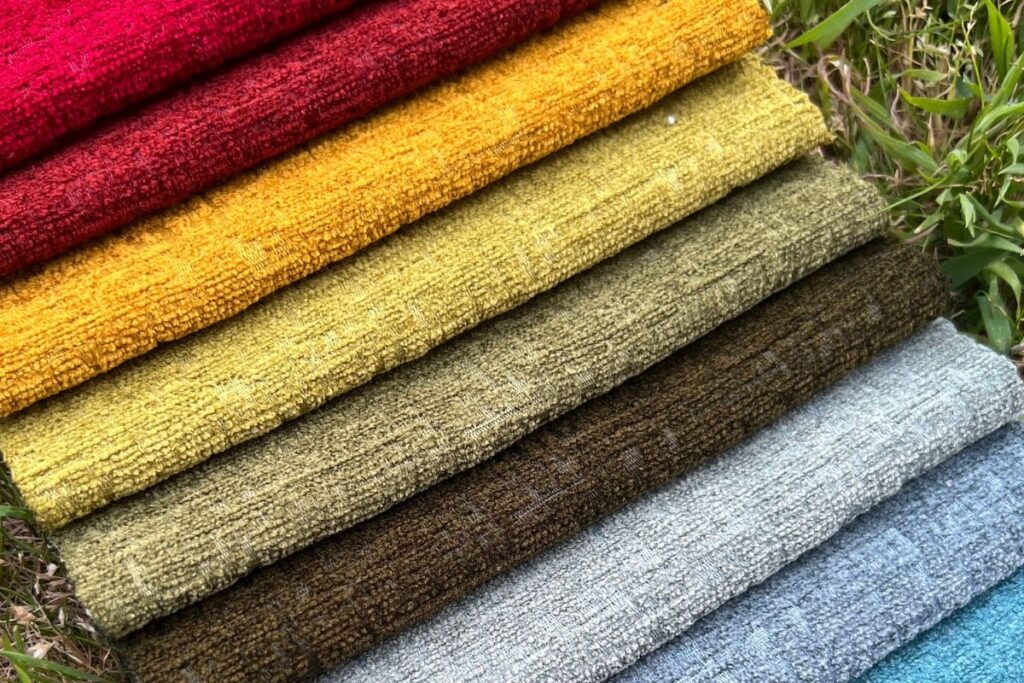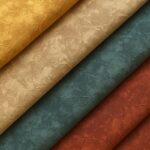Chenille fabric is one of the most beautiful tasseled and fuzzy fabrics with smooth feel to the touch. It is usually compared to the appearance of the material called a caterpillar and this is where the name chenille fabric origins as it translates “caterpillar” in french. The structure of the cloth is made up of yarn loops where chenille is produced using short lengths of yarn sandwiched between a pair of core yarns, resembling cuts on a plush fabric.
Why is Chenille Called Shaneel in India?

As for shaneel fabric, it is what chenille fabric is known as in India. Countries like India have shaneel as a term that is often used and it is mainly used in the textiles markets of Delhi, Mumbai, and Surat. Thus, the term “shaneel fabric” as used in the English context means “chenille fabric.”
This sort of dual naming occurs in India where the influence of local dialects are very strong.
Properties of Chenille Material
| Property | Description |
|---|---|
| Texture | Soft, plush, and velvet-like |
| Appearance | Slight sheen; rich and vibrant colors |
| Durability | Strong but requires gentle handling and washing |
| Composition | Often made from cotton, rayon, polyester, or acrylic |
| Warmth | Excellent insulator, ideal for colder climates |
| Maintenance | Hand-wash or dry-clean preferred to maintain shape |
Uses of Chenille Cloth in Fashion and Home Décor
Chenille fabric is used in leisure apparel, such as sweaters and scarves, and is also suitable for home décor:
- Cardigans: Scarves, sweaters, and loungewear
- Sofas: Armchairs and upholstery
- Drapes: Affluent curtains and drapes for homes.
- Throws: Bundles of blankets and throws designed to be soft during winter
Ranging from carpets to rugs, chenille cloth is extensively applied across textiles to provide warmth during colder months.
Chenille vs Other Fabrics
| Feature | Chenille Fabric | Velvet | Fleece |
|---|---|---|---|
| Texture | Soft and fuzzy | Smooth and glossy | Soft, slightly fluffy |
| Common Use | Home décor, winterwear | Evening wear | Casual outerwear |
| Cost | Moderate | Expensive | Affordable |
| Breathability | Medium | Low | Medium |
Top Chenille Fabric Exporters in India
India holds a number of strap fabric production cities that compete globally. That said, these are their flagship cites:
- Panipat, Haryana – Specialized in home furnishings that use chenille fabrics methods.
- Surat, Gujarat – Known for bulk production of synthetic shaneel cloth
- Erode, Tamil Nadu – Popular for chenille yarn and textiles
The United States, United Kingdom, Australia, and even the United Arab Emirates are at the forefront for high-end yet reasonable chenille item marketplaces serviced by various Indian exporters.
Conclusion
Most people that appreciate chenille fabric, also know it as shaneel cloth. This creative fabric adds comfort and sophistication to any setting. In India and rest of the world, it remains a popular option for winter clothes or regal upholstery as teh versatility of teh material is unmatched.
Also Read This: Velvet Fabric
Frequently Asked Questions (FAQs)
1. What is shaneel fabric in English?
Shaneel fabric in English is called chenille fabric. Both terms refer to the same soft, fuzzy material.
2. Is chenille a natural fabric?
Chenille can be crafted from both natural fibers like cotton as well as synthetic ones such as polyester or acrylic.
3. What are the disadvantages of chenille fabric?
However, chenille does not have many advantages as it is prone to stretching and requires gentle cycle wash to prevent damage or fraying.
4. Where is chenille fabric commonly used?
It’s widely used in home furnishings like curtains, sofa covers, and bedspreads, as well as winter clothing.
5. Is chenille fabric suitable for summer?
The insulating properties of chenille fabric make it best suited for air-conditioned environments or cooler climates.




1 thought on “Chenille Fabric: Meaning, Uses & Why It’s Called Shaneel in India”